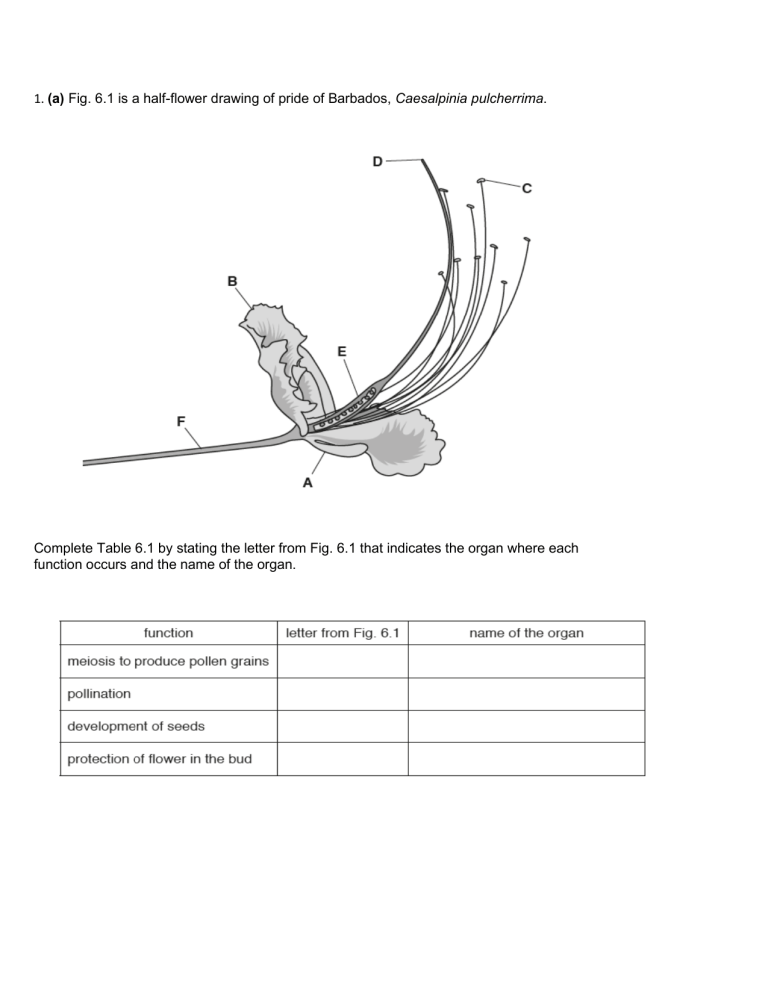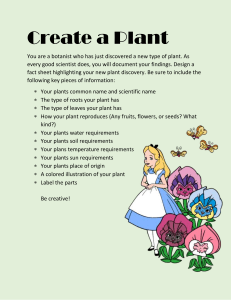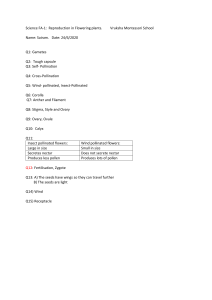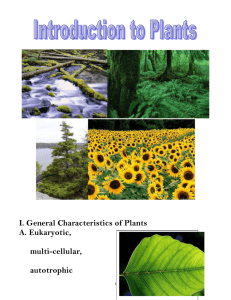Plant Biology Exam: Flower Anatomy, Pollination, Seed Germination
advertisement

1. (a) Fig. 6.1 is a half-flower drawing of pride of Barbados, Caesalpinia pulcherrima. Complete Table 6.1 by stating the letter from Fig. 6.1 that indicates the organ where each function occurs and the name of the organ. B) Fig. is a scanning electron micrograph of some pollen grains from wind-pollinated flowers and insect-pollinated flowers. (i) Write the formula that would be used to calculate the actual diameter of pollen grain H. (ii) The actual diameter of pollen grain H is 0.082 mm. Convert this value to micrometres (μm). Space for working. ..................................................... μm (iii) Explain how the pollen grain labelled J is adapted for insect pollination. .......................................................................................................................................... .......................................................................................................................................... .......................................................................................................................................... .......................................................................................................................................... C) Pollen grains grow tubes, which contain haploid male gamete nuclei. (i) One of these male gamete nuclei fuses with the female gamete. State the part of the flower that contains the female gamete. ...................................................................................................................................... (ii) Define the term haploid nucleus. .......................................................................................................................................... .......................................................................................................................................... ...................................................................................................................................... (iii) Explain why it is important for gametes to be haploid. .......................................................................................................................................... .......................................................................................................................................... 2A) The students provided the environmental conditions that seeds need to germinate. State two of these environmental conditions. 1 ....................................................................................................................................... 2 ....................................................................................................................................... B) One group of students recorded the change in temperature as the seeds germinated in five insulated flasks, labelled A to E. (i) Suggest why germinating seeds increase in temperature. .......................................................................................................................................... .......................................................................................................................................... ...................................................................................................................................... (ii) The students sterilised the seeds before their investigation. Their teacher told them to use a sterilising solution to wash the seeds because steam would kill the seeds and prevent the seeds from germinating. Explain why steam sterilisation would prevent seed germination. .......................................................................................................................................... ...................................................................................................................................... The results from this group of students are shown in Table (iii) Describe the results obtained by group 1. .......................................................................................................................................... .......................................................................................................................................... .......................................................................................................................................... .......................................................................................................................................... C) The second group of students placed 100 seeds in each of five Petri dishes, labelled 1 to 5. Group 2 used the same range of pH values as group 1. They recorded the percentage of seeds that had germinated after 72 hours. Their results are shown in Table The teacher thought that group 2 had forgotten to add the sulfuric acid to one of their Petri dishes. Suggest which Petri dish was not set up correctly. .............................................................................................................................................. 3A) The flowers of pea plants can be pollinated by bees. (a) State three features of flowers that would attract insects such as bees. 1 ............................................................................................................................................... .................................................................................................................................................. 2 ............................................................................................................................................... .................................................................................................................................................. 3 ............................................................................................................................................... .................................................................................................................................................. B) (b) Successful pollination results in fertilisation. Describe the events that occur after pollen grains leave the anther of a flower until fertilization takes place. .................................................................................................................................................. .................................................................................................................................................. .................................................................................................................................................. .................................................................................................................................................. .................................................................................................................................................. .................................................................................................................................................. .................................................................................................................................................. 4) The garden pea, Pisum sativum, is a plant which has flowers that have both male and female parts. P. sativum is naturally self-pollinating. Discuss the advantages and disadvantages of self-pollination. .................................................................................................................................................. .................................................................................................................................................. .................................................................................................................................................. .................................................................................................................................................. .................................................................................................................................................. .................................................................................................................................................. .................................................................................................................................................. .................................................................................................................................................. 5) Rhabdostyla is a single-celled organism that has no cell wall and no chlorophyll. Gases are exchanged across the cell membrane of Rhabdostyla. Name: the gas produced by Rhabdostyla .................................................................................... the process that produces the gas ................................................................................... the method of removal of the gas ..................................................................................... 6) Anthocyanin is a red pigment found in carnation flowers. Some carnation plants have a gene for making anthocyanin. (i) A flower grower bred red carnations. Describe how growers selectively breed plants. ............................................................................................................................... ............................................................................................................................... ............................................................................................................................... ............................................................................................................................... ............................................................................................................................... ............................................................................................................................... ............................................................................................................................... (ii) Explain the disadvantages of using sexual reproduction to breed red carnations. ............................................................................................................................... ............................................................................................................................... ............................................................................................................................... ............................................................................................................................... 7) The root shown in Fig. 5.1 is growing downward into the soil. Name this response seen in roots. ......................................................................................................................................



